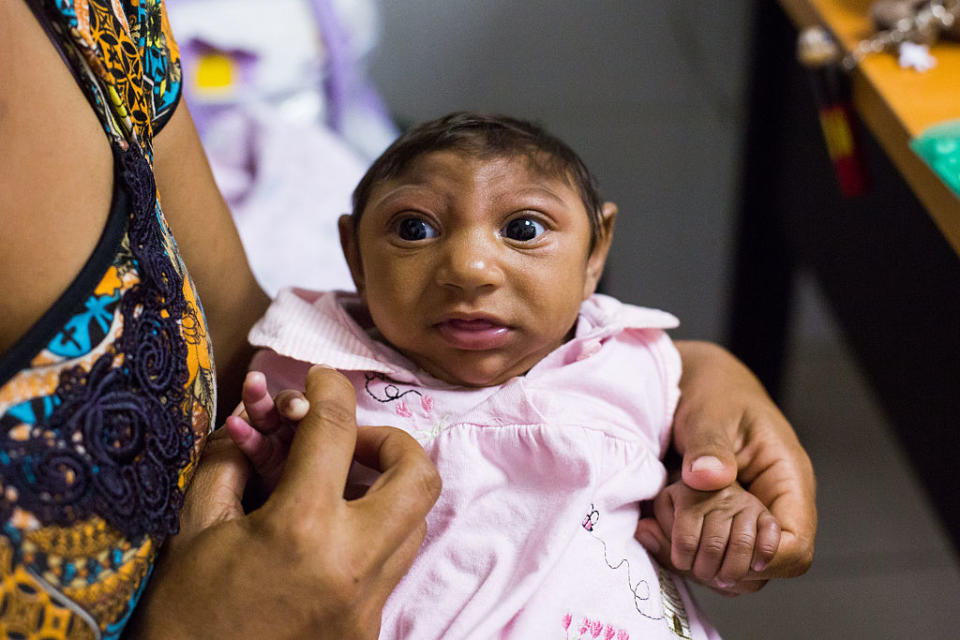14 Things You Need to Know About CMV


While everyone’s been busy worrying about babies contracting Zika (and for good reason), another viral infection has been quietly causing thousands of birth defects in the U.S. each year: “I don’t want to undermine the tragedy of Zika, but it’s important to recognize that for a long time, we’ve had this other virus that causes microcephaly and injures babies,” says Mark Schleiss, MD, the director of pediatric infectious disease and immunology at the University of Minnesota Medical School.
The virus he’s referring to is cytomegalovirus (CMV), and it affects upward of 40,000 infants annually, causing permanent birth defects and developmental disabilities among some 8,000 of those babies.
While there isn’t a CMV vaccine yet, awareness about the virus and its effects can help everyone avoid infection and minimize the risk of women passing the virus along to their unborn babies. So, here’s what you need to know about the other virus people should be talking about - particularly if parenting is on your bucket list:
1. You could have CMV right now without even knowing it. One in 3 kids in the U.S. will pick it up by the time they turn 3 years old, and approximately half of all adults contract it by the time they reach their 40s, according to the Centers for Disease Control. In other words, CMV is pretty freaking common.
What’s more, fewer than 25 percent of people who get it experience any symptoms at all, according to Dr. Schleiss, who adds that even then, symptoms tend to be pretty mild and similar to the ones you experience when you come down with a cold. You might feel a little tired, feverish, or notice swollen glands or a sore throat, all of which tend to go away on their own within a few weeks. It’s why you might not even realize you have CMV or know when you’re spreading it.
In rare cases, CMV can cause mononucleosis, or more serious complications among people who have weakened immune systems from chemotherapy or organ transplants. But again, those are special situations that won’t affect the majority.
2. Although it’s common, CMV is hard to catch. Spread through bodily fluids like urine, saliva, tears, semen, breast milk, mucus, and blood, CMV isn’t airborne or considered to be highly contagious. “You don’t get CMV from casual contact like riding the bus; it’s from exchanging body fluids at an intimate level,” Dr. Schleiss explains, referring to kissing, sex, sharing cups and eating utensils, or changing an infected child’s diaper without washing your hands well enough afterward - all of which can end up transmitting the virus into your body.
3. Close contact with babies and toddlers increases your risk of exposure. Day care workers and babysitters who feed and diaper multiple children all in a day’s work are bound to come in contact with lots of bodily fluids, whether they’re wiping one kid’s nose or changing another’s diaper. Because toddlers who have CMV can project perfect health, it’s that much easier to pick up CMV unknowingly - particularly when you work with kids who are younger than 3, about the age where kids begin to master potty training and practice proper hygiene.

4. Once you’ve got CMV, it stays in your system forever. A type of herpes virus, CMV remains dormant in your body just like chickenpox and mono, laying low even after any noticeable symptoms subside. When dormant, it’s not contagious, but can reactivate and become contagious at any time, unbeknown to the carrier. Besides undergoing therapies that weaken your immune system - like taking drugs to prevent your body from rejecting an organ in case of a transplant - experts don’t know exactly which scenarios support reactivation in the average person.
5. Careful hygiene can protect you from CMV. Because your immune system is always on the defense, exposure to an active strain of CMV doesn’t necessarily guarantee transmission. To reduce your risk of contracting the virus, avoid saliva-swapping activities like kissing kids on the mouth and cheeks, and sharing plates or eating utensils with them, even if they’re family members, according to the National CMV Foundation. You’ll also want to thoroughly wash your hands by lathering up with soap for at least 20 seconds after coming into contact with a child’s bodily fluids - particularly if you’re pregnant.
6. You really don’t want to contract CMV while you’re pregnant. That’s because, when active, the virus circulates in your blood stream and can cross the placenta to infect your developing baby, resulting in what’s known as congenital CMV.

7. Babies that contract congenital CMV can develop serious birth defects and developmental issues, particularly when they’re exposed early on. “Problems can range from profound, like multi-system failure, pneumonia, microcephaly [the same defect caused by Zika], and eventual death, to completely normal outcomes,” Dr. Schleiss says, adding that the worst outcomes tend to follow exposure to a developing baby’s brain or central nervous system between the 12th and 20th weeks of pregnancy, a critical period for development. Other complications can also include hearing and vision loss, mental disability, cerebral palsy, failure to thrive, behavioral issues, and seizures, according to the National CMV Foundation (NCMF).
Among CMV babies, 3 out of 4 who display symptoms at birth, like a small birth size for their age, yellow skin or rashing, a small head, or enlarged liver or spleen, will experience even more challenges as they grow up, according to the NCMVF.
8. CMV is the leading cause of deafness in children. Now that vaccines have wiped out other widespread causes of hearing loss such like meningitis, CMV is the single most common infectious disease that causes deafness in children, according to Dr. Schleiss. The disability can be present at birth or develop month or years down the line even when a fetus is exposed to CMV toward the end of their mother’s pregnancy. That said, most babies who have hearing loss because of CMV have otherwise normal brain development, according to Dr. Schleiss.

9. CMV affects more babies than fetal alcohol syndrome, neural tube defects, and Down’s syndrome, combined - plus Zika. “Women know they shouldn’t drink while pregnant to prevent fetal alcohol syndrome, that they should take folic acid to prevent neural tube defects, and that they should avoid getting pregnant later in in life to avoid the heightened risk of having a baby with Down’s syndrome,” he says. “But more babies are damaged by CMV every year than all of those adverse outcomes together,” he adds, to put things in perspective.
So far as Zika is concerned: While a baby exposed to Zika in the womb is more likely to be born with birth defects and developmental disabilities than a baby who’s exposed to CMV during its development , CMV is so much more prevalent than Zika in the U.S. that more babies end up affected by CMV than Zika. FWIW, with both viruses, the earlier a baby is exposed, the greater the risk of developmental issues.
10. Second children are more likely to be born with CMV. Because mothers are more likely to be exposed to CMV picked up by their own children in day care or playgroups, women are more likely to contract CMV the second time they get pregnant, a bad thing considering the virus can do the most damage to a fetus when a woman is infected for the first time during her pregnancy.
11. The majority of babies exposed to CMV in the womb will end up perfectly fine. Dr. Schleiss estimates that 8 out of 10 CMV babies will lead normal lives without any disabilities at all. This prognosis is totally different from that of Zika, which causes devastating outcomes in the majority of babies who are exposed to Zika early in pregnancy.

12. Doctors have the tools to detect CMV in pregnant women and unborn babies, but testing isn’t standard. Although there’s no test to predict exactly how CMV will affect any given baby, testing a pregnant woman’s blood or amniotic fluid can help detect a fetus’s CMV infection early. This can help a woman decide whether to terminate her pregnancy, enroll in a clinical trial that could improve the baby’s outcome, help pediatricians anticipate developmental problems, or dictate whether a doctor prescribes antiviral medication at birth, which does appear to help prevent hearing and developmental issues, according to Dr. Schleiss.
While monitoring for CMV during pregnancy is commonplace in Europe, those tests aren’t mandated by the American Congress of Obstetricians and Gynecologists, (ACOG) the organization that sets the standards for prenatal care in the U.S.
“Routine testing would put CMV on the grid so women begin to talk about it,” says Dr. Schleiss, who adds that most parents of CMV patients he’s treated never heard of the virus before their kids’ diagnosis. In the meantime, pregnant women can always ask their doctors to be tested.
13. Transmission of CMV to your baby through breastfeeding should be the least of your worries. Save for preemies and low-birth weight babies, for which more research is needed, infecting a full-term baby with CMV by feeding them breast milk is far preferable to not breastfeeding at all. That’s because CMV is unlikely to cause any symptoms, and the risk of developmental issues linked to the virus subsides once a full-term baby is born, according to Dr. Schleiss. “Breastfeeding is always best,” he adds.

14. CMV vaccines are being tested as we speak, TG. Because testing involves following CMV children for years to evaluate the virus’s outcomes, progress is slow coming. But it is coming.
Follow Elizabeth on Twitter and Instagram.
You Might Also Like


